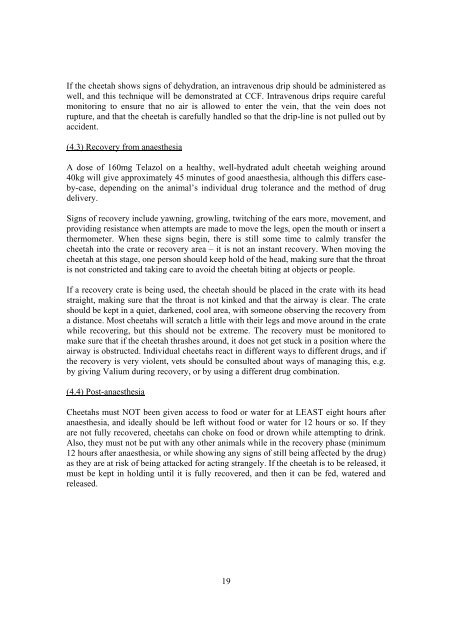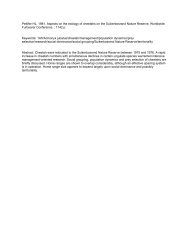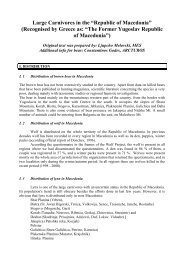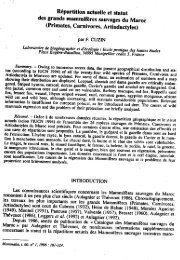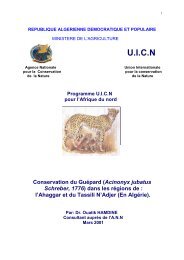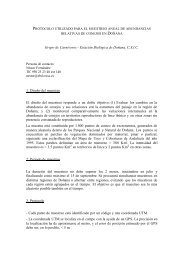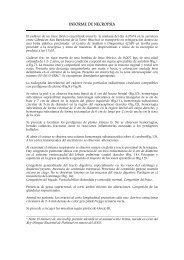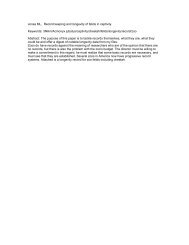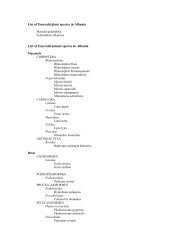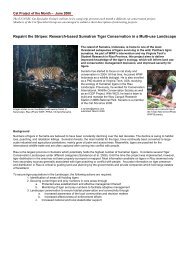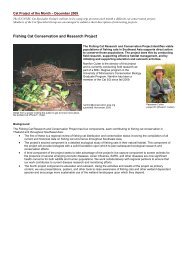cheetah capture and immobilisation handbook - Cat Specialist Group
cheetah capture and immobilisation handbook - Cat Specialist Group
cheetah capture and immobilisation handbook - Cat Specialist Group
You also want an ePaper? Increase the reach of your titles
YUMPU automatically turns print PDFs into web optimized ePapers that Google loves.
If the <strong>cheetah</strong> shows signs of dehydration, an intravenous drip should be administered as<br />
well, <strong>and</strong> this technique will be demonstrated at CCF. Intravenous drips require careful<br />
monitoring to ensure that no air is allowed to enter the vein, that the vein does not<br />
rupture, <strong>and</strong> that the <strong>cheetah</strong> is carefully h<strong>and</strong>led so that the drip-line is not pulled out by<br />
accident.<br />
(4.3) Recovery from anaesthesia<br />
A dose of 160mg Telazol on a healthy, well-hydrated adult <strong>cheetah</strong> weighing around<br />
40kg will give approximately 45 minutes of good anaesthesia, although this differs caseby-case,<br />
depending on the animal’s individual drug tolerance <strong>and</strong> the method of drug<br />
delivery.<br />
Signs of recovery include yawning, growling, twitching of the ears more, movement, <strong>and</strong><br />
providing resistance when attempts are made to move the legs, open the mouth or insert a<br />
thermometer. When these signs begin, there is still some time to calmly transfer the<br />
<strong>cheetah</strong> into the crate or recovery area – it is not an instant recovery. When moving the<br />
<strong>cheetah</strong> at this stage, one person should keep hold of the head, making sure that the throat<br />
is not constricted <strong>and</strong> taking care to avoid the <strong>cheetah</strong> biting at objects or people.<br />
If a recovery crate is being used, the <strong>cheetah</strong> should be placed in the crate with its head<br />
straight, making sure that the throat is not kinked <strong>and</strong> that the airway is clear. The crate<br />
should be kept in a quiet, darkened, cool area, with someone observing the recovery from<br />
a distance. Most <strong>cheetah</strong>s will scratch a little with their legs <strong>and</strong> move around in the crate<br />
while recovering, but this should not be extreme. The recovery must be monitored to<br />
make sure that if the <strong>cheetah</strong> thrashes around, it does not get stuck in a position where the<br />
airway is obstructed. Individual <strong>cheetah</strong>s react in different ways to different drugs, <strong>and</strong> if<br />
the recovery is very violent, vets should be consulted about ways of managing this, e.g.<br />
by giving Valium during recovery, or by using a different drug combination.<br />
(4.4) Post-anaesthesia<br />
Cheetahs must NOT been given access to food or water for at LEAST eight hours after<br />
anaesthesia, <strong>and</strong> ideally should be left without food or water for 12 hours or so. If they<br />
are not fully recovered, <strong>cheetah</strong>s can choke on food or drown while attempting to drink.<br />
Also, they must not be put with any other animals while in the recovery phase (minimum<br />
12 hours after anaesthesia, or while showing any signs of still being affected by the drug)<br />
as they are at risk of being attacked for acting strangely. If the <strong>cheetah</strong> is to be released, it<br />
must be kept in holding until it is fully recovered, <strong>and</strong> then it can be fed, watered <strong>and</strong><br />
released.<br />
19


